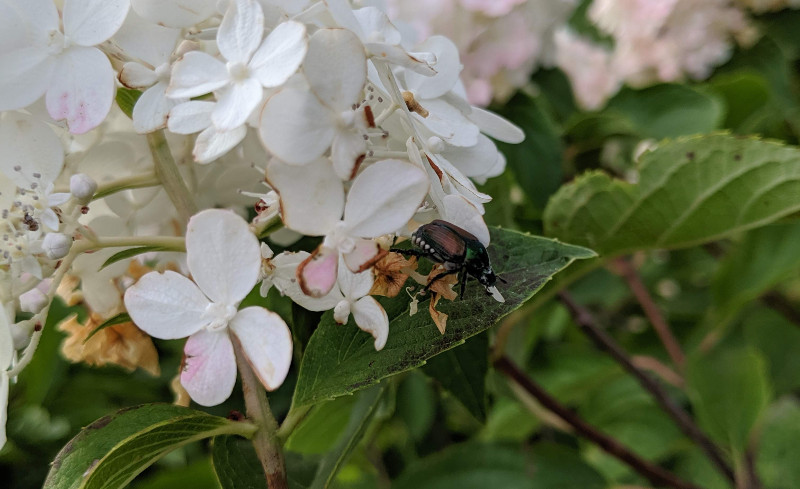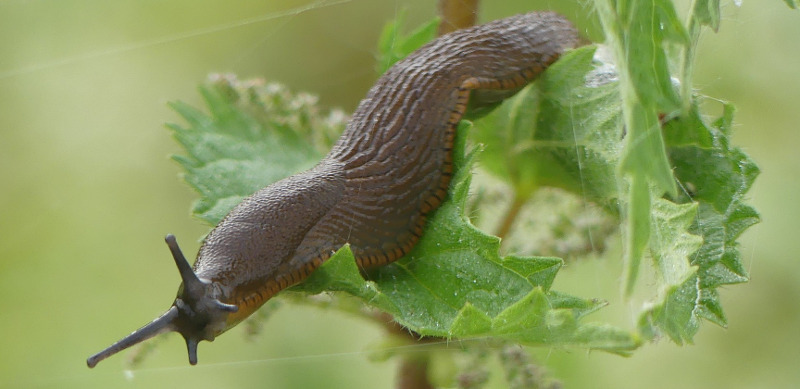If you notice holes in the leaves of your hydrangeas or entire branches are missing, you may have a pest problem. Although most pests do not bother hydrangeas, there are some common ones that gardeners have to deal with from time to time. Here are the most common pests:
Aphids on Hydrangeas
Aphids are very small, soft-bodied insects that insects that pierce plant stems with their tiny mouths to feed on plant sap. These insects will typically be attracted to new growth, as it is easier to pierce the stem wall to get to the sap. An easy way to tell if aphids may be the problem, is by looking for ants. Ants love to feed on the honeydew substance left behind by aphids.

Treating Aphids on Hydrangeas
The first line of defense to to spray the areas where you suspect aphids are located with a strong water jet from the hose. Be careful not to spray so hard that you damage the plant. Also, if you have black spots on your hydrangea, we do not recommend this method as it will cause extra moisture on the leaves.
If a strong stream of water isn’t an option or working, you can spray an insecticidal soap solution on the leaves and stems. Use as directed on the bottle.
Japanese Beetles on Hydrangeas
You can’t miss these large beetles when they arrive in the dead of summer. These have shiny green and brown bodies and will eat through hydrangea leaves and many other plants in your garden. If you do not remove these fast, swarms of beetles have been known to take down entire plants in a matter of days. While this rarely kills the plant, it leaves it looking very unsightly for the rest of the year.

Treating Japanese Beetles on Hydrangeas
We recommend hand picking these beetles and putting them into a bucket of soapy water. Or you can crush them with your fingers as some gardeners get a sadistic pleasure when dealing with these demonic insects. It is best to do this in the morning when the beetles are moving the slowest.
There are mixed reviews on getting Japanese beetle traps that use pheromones to catch the bugs. The traps do work well, but some gardeners say that it attracts even more Japanese Beetles from surrounding areas.
Slugs on Hydrangeas
Slug, or land slugs, tend to attack young hydrangeas. You can tell if they are a problem when you see ragged edges and holes in the hydrangea leaves. Although some slugs prefer to eat old decaying material, others prefer new, tender growth and can leave the foliage of your hydrangea looking tattered.

Treating Slugs on Hydrangeas
The best time to try and find the slugs actually on the plants is at night. You can pick them off the plant and drown them in a bucket of soapy water. Alternatively, you can lay slug traps around the plants or sprinkle a slug bait containing iron phosphate around the base.
Spider Mites on Hydrangeas
Spider mites are tiny insects that are almost invisible to the naked eye. These tiny bugs live underneath the leaves of hydrangeas, where they spin protective silk webs. The webs are the best way to tell if spider mites are present. These insects will puncture the plant cells to feed, which damages the leaves.
Treating Spider Mites on Hydrangeas
Ladybugs are the best way to control spider mites. We recommend planting other plants that will attract ladybugs around your garden. Or you can purchase ladybugs to release in your yard. Attracting beneficial predators is the best way to control spider mites without having to resort to using insecticides, which may harm other insects that are helpful to have in your yard.
Spider mites like hot and dry conditions as well. So you can often prevent the bugs from making a home on your hydrangea by keeping the plants well watered throughout the summer.
Another question we often get is Are Hydrangeas Deer Resistant?
 |
Author Chris Link - Published 08-04-2019 |
